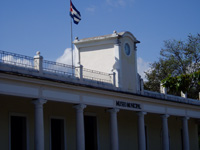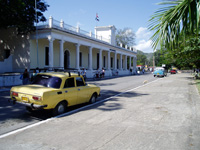Address: Calle: 30 e/ 37 y 39.
Telf: 005346 323791
 The Municipal Museum of Isla de la juventud is one of the oldest buildings in town. It was built by the Spanish in 1853. The Municipal Museum of Isla de la juventud is one of the oldest buildings in town. It was built by the Spanish in 1853.
It was used originally as city council until 1963.
From that time it had several uses: office of the local commissioner, economy school, language school, elementary school, and pedagogy school.
In 1995 the building was transferred to the Municipal patrimony centre to become the Municipal Museum of the Island.
In 1996 a compilation of information about the island began. People were encouraged to give suggestions about what they felt should be represented at the future museum.
On May 13, 2000 the museum was officially opened.
This museum is divided into different rooms:
Room 1 - Preamble.
This room was the hall of council members during when is as the City Hall. It is used for formal events. There is plaster mural depicting a scroll and inside a map of the Isle of Youth. This piece was carried out by two highly respected local artists, Idyll and Fran.
Room 2 - Overview Aboriginal and piracy.
This room has a small part about the Aboriginal settlements as well as their tools, and objects that period. There are also several photographs of Punta del Este caves showing pictures of the culture, and customs of that period.
Photographs of the main pirates of the era and a replica of a galleon are shown too.
Room 3 - Colony.
In this room can bee seen the historical events since Nueva Gerona was founded on December 17, 1830 with pictures and documents of July 26, 1896 which states the first attempt of uprising against Spain. Also, the confinement of Jose Marti. Photos of deportees and the first buildings on the island.
Room 4 - Neo-colonial
This room covers the neo-colonial era, but also some historical events as the proclamation of the sovereignty of the island as Cuban territory was in the Hay-Quesada treaty of March 7, 1925. There is a cannon used on the day of proclamation.
 Also photos of the mayors of the island until 1959, as the different ferryboats used as mean of transport from Havana and the island, also the model of the ship El Pinero which now is a National Monument. Also photos of the mayors of the island until 1959, as the different ferryboats used as mean of transport from Havana and the island, also the model of the ship El Pinero which now is a National Monument.
Room 5 - Immigration.
In this room, objects such as dishes used by ancient dwellers of the island: Japanese, American Caimaneros are shown.
The American who introduced pottery in the island was Harriet P Mrs Wheeler.
 You can also see the first radio that existed in the town of Jacksonvillie, known today as Crocodile. You can also see the first radio that existed in the town of Jacksonvillie, known today as Crocodile.
Room 6 - Revolution.
In this room, photos and documents of the time of the Cuban revolution, and the bombing of the ship El Baire, are shown. By the way, there are parts of this ship as the rudder.
The transcription of the speech given by Raul Roa on August 2, 1968 proclaiming La isla de la juventud.
Also in the same room there are pictures of Cubans who fought in other countries like in Africa.
Objects that foreign students donated to the Island.
Room 7 - Art.
In this room, original works donated by artist Alexis Leiva Machado are displayed. Also works by other artists such as René Portocarrero, Mariano Rodrigues and others.

Museo Municipal de Nueva Gerona o Ayuntamiento - Isla de la Juventud
|

Museo Municipal de Nueva Gerona o Ayuntamiento - Isla de la Juventud
|
|